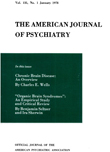HOW BRAIN LESIONS AFFECT NORMAL AND NEUROTIC BEHAVIOR
Abstract
Over a period of 6 years 50 cats and 40 monkeys were closely observed for (1) their individual and social characteristics; (2) their capacity to learn various skills; and (3) the form and persistence of the experimental neuroses induced in 23 cats and 18 monkeys by exposure to adaptational conflicts. The animals were then subjected severally to lesions of the anterior or mediodorsal thalamus, the amygdalae, or cerebral areas 13, 23, or 24. The results to date indicate that the general and specific effects of cerebral lesions vary not only with their site and extent but also with (1) the preoperative experiences of each animal and (2) its postoperative care and re-training.
Access content
To read the fulltext, please use one of the options below to sign in or purchase access.- Personal login
- Institutional Login
- Sign in via OpenAthens
- Register for access
-
Please login/register if you wish to pair your device and check access availability.
Not a subscriber?
PsychiatryOnline subscription options offer access to the DSM-5 library, books, journals, CME, and patient resources. This all-in-one virtual library provides psychiatrists and mental health professionals with key resources for diagnosis, treatment, research, and professional development.
Need more help? PsychiatryOnline Customer Service may be reached by emailing [email protected] or by calling 800-368-5777 (in the U.S.) or 703-907-7322 (outside the U.S.).



